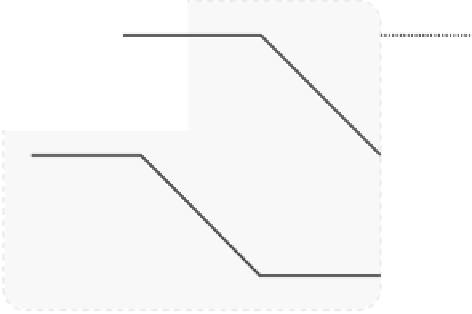Cryptography Reference
In-Depth Information
dealer
player 1
ψ
in
secret state
1:1
player 2
φ
OPA
EPR
entangled
beams
pump
1:1
φ
player 3
OPA
Figure 8.4
Schematc of the dealer protocol for the (2,3) quantum state sharing scheme.
OPA: optical parametric amplifier;
ψ
in
: secret quantum state; 1:1: 50% reflectivity
beamsplitter;
φ
phase delay.
correlations of both the amplitude and phase quadratures between the beams.
We therefore call the state
quadrature entangled
. Such entanglement is directly
analogous to the particle position-momentum entanglement described by
Einstein, Podolsky and Rosen [21], and as such it can be used to demonstrate
the EPR paradox [16].
The dealer generates the players' shares by interfering the secret state
a
in
with one of the entangled beams
a
EPR1
on a 1:1 beam splitter. The two result-
ing output fields and the second entangled beam
a
EPR2
form the three shares
that are distributed to the players, as shown in Figure 8.4. The entangled state
ensures that the secret is protected from each player individually. The dealer
can further enhance the security of the scheme by displacing the coherent
amplitudes of the shares with correlated Gaussian white noise [19]. This ad-
ditional security can be arbitrarily enhanced by the dealer by increasing the
variance of the added Gaussian noise. By choosing the Gaussian noise to have
the same correlations as the quadrature entanglement, the shares can then be
expressed as
√
2
a
1
=
(
a
in
+
a
EPR1
+
δ
N
)/
(8.3)
√
2
a
2
=
(
a
in
−
a
EPR1
−
δ
N
)/
(8.4)
N
∗
a
3
=
a
EPR2
+
δ
(8.5)
δ
=
(δ
N
+
+
δ
N
−
)/
δ
N
±
where
N
i
2 represents the Gaussian noise with mean
=
denotes the complex conjugate. The recon-
struction protocol used for the (2,3) quantum state sharing scheme is depen-
dent on which players constitute the access structure. The next section exam-
ines the reconstruction protocols used by the different access structure sets.
0 and variance
(δ
N
±
)
2
, and
∗
































